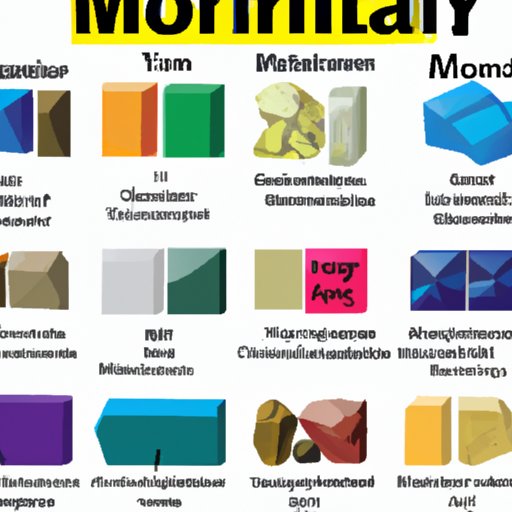
An Overview of the Definition of Mineral
Minerals are naturally occurring substances that form part of the Earth’s crust. They have unique chemical compositions and physical properties that make them essential components of rocks and soils. Minerals are found in abundance in the Earth’s surface and are used for various purposes including industrial, commercial and scientific applications.
Definition of Mineral
According to the International Union of Geological Sciences (IUGS), a mineral is “a naturally occurring solid, inorganic, crystalline substance having a definite chemical composition, characteristic crystalline structure, and specific physical properties.” In other words, a mineral is an element or compound that is found in nature and has a specific chemical composition, crystal structure and physical properties.
Characteristics of Minerals
Minerals can be identified by their distinct physical and chemical properties. These include:
Chemical Composition
The chemical composition of a mineral is determined by the elements that make up the mineral. For example, quartz is composed of silicon and oxygen, while calcite is composed of calcium, carbon and oxygen. Each type of mineral has a unique chemical composition.
Crystal Structure
The crystal structure of a mineral is determined by how its atoms are arranged in space. Different minerals have different crystal structures, which can be seen under a microscope. For example, quartz has a hexagonal crystal structure while calcite has a rhombohedral crystal structure.
Hardness
The hardness of a mineral is measured on the Mohs scale, which ranges from 1 (softest) to 10 (hardest). For example, talc has a hardness of 1, while diamond has a hardness of 10.
Density
The density of a mineral is determined by its mass per unit volume. Different minerals have different densities, which can be measured using a balance. For example, quartz has a density of 2.65 g/cm3 while calcite has a density of 2.71 g/cm3.
Color and Streak
The color of a mineral is determined by the elements that compose it. The streak of a mineral is the color of its powder form when rubbed against a white tile. Different minerals have different colors and streaks, which can be used to identify them.
Types of Minerals and Their Uses
Minerals can be divided into four main categories based on their uses: common minerals, industrial minerals, metals and gemstones.
Commonly Found Minerals
Commonly found minerals include quartz, feldspar, mica, olivine and calcite. These minerals are mostly used as building materials, such as gravel, sand and cement. They are also used in the production of glass, ceramics and jewelry.
Industrial Minerals
Industrial minerals are minerals that are used in industries such as manufacturing, construction and agriculture. Examples include talc, gypsum, limestone and bentonite. These minerals are used in the production of various products such as paper, plastics, paint and fertilizers.
Metals
Metals are minerals that can be melted and shaped into various objects. Examples include gold, silver, copper and iron. These minerals are used in the production of coins, jewelry, tools and machinery.
Gemstones
Gemstones are minerals that are cut and polished for use in jewelry. Examples include diamonds, rubies, sapphires and emeralds. These minerals are used in the production of rings, earrings, necklaces and other pieces of jewelry.

Examining the Role of Minerals in Nature
Minerals play an important role in nature. They provide essential nutrients to plants and animals, and they help to maintain the balance of the environment. Minerals also provide economic benefits, as they are used in a variety of industries.
Environmental Benefits
Minerals help to maintain the balance of the environment by providing essential nutrients to plants and animals. They also help to regulate the climate by absorbing heat and reflecting sunlight. Furthermore, minerals can help to reduce air and water pollution by filtering out contaminants.
Biological Benefits
Minerals are essential for the growth and development of living organisms. According to research conducted by the University of Arizona, minerals are essential for “the formation of bones, teeth, muscles and other tissues, as well as for regulating metabolic processes and providing energy for cellular activities.”
How to Identify Minerals – A Guide
Identifying minerals can be done by examining their visual characteristics, physical properties and chemical composition. Here is a step-by-step guide on how to identify minerals:
Visual Identification
The first step in identifying a mineral is to examine its visual characteristics, such as its color, luster, shape and pattern. Different minerals have different visual characteristics, which can be used to differentiate them.
Physical Properties Testing
The next step is to test the physical properties of the mineral, such as its hardness, cleavage, fracture and streak. Different minerals have different physical properties, which can be used to identify them.
Chemical Tests
Finally, the chemical composition of the mineral can be tested using chemical tests. These tests involve adding a solution to the mineral sample and observing the reaction. Different minerals have different chemical compositions, which can be identified using these tests.
Minerals are essential components of rocks and soils, and they play an important role in nature. They provide essential nutrients to plants and animals, and they help to maintain the balance of the environment. Understanding the definition of mineral, its characteristics, types and role in nature is essential for identifying and utilizing minerals.
(Note: Is this article not meeting your expectations? Do you have knowledge or insights to share? Unlock new opportunities and expand your reach by joining our authors team. Click Registration to join us and share your expertise with our readers.)
